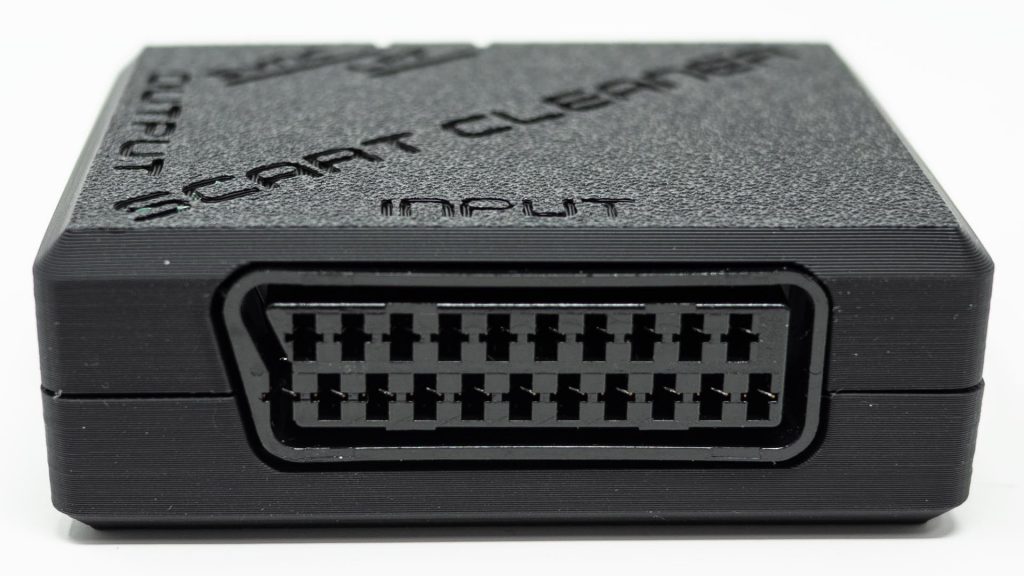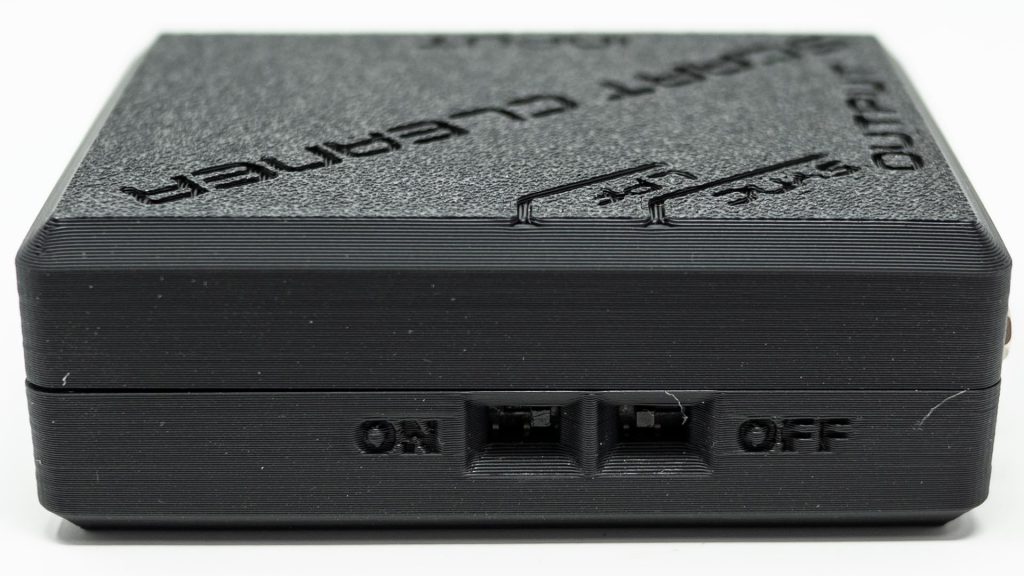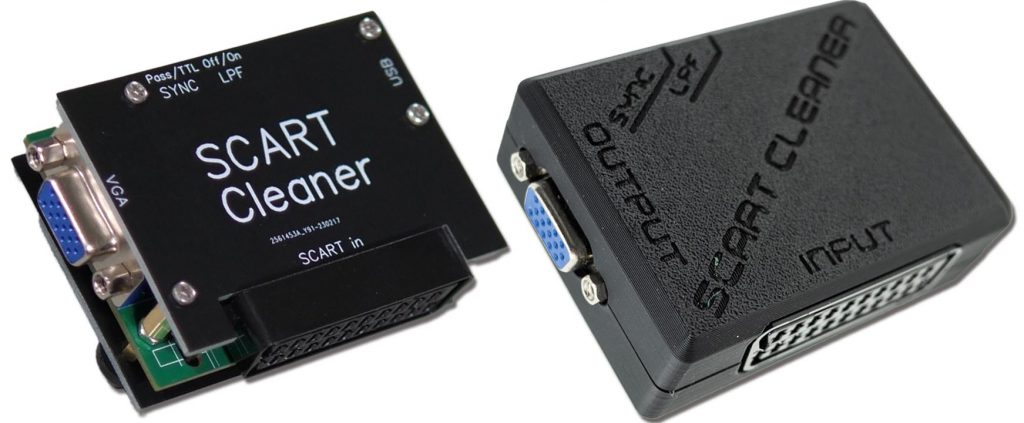The SCART Cleaner is designed to be used with Datapath Vision capture cards, or Extron equipment that require a clean, high voltage (TTL) sync signal. This is NOT a “SCART to VGA converter” – The signal that comes out is the exact same RGBs signal that’s input, with only the sync and output connector being changed. Please read this page for more info:
The SCART Cleaner is an open-source (CERN OHLv2) device, however the 3D-Printed case shown above on the right is a private design. You can either purchase it as a complete unit from a vetted reseller with the 3D printed case, or make your own with the open source PCB-style case.
Purchase:
US Seller: https://retrorgb.link/scartcleaner
UK Seller: Coming Soon
Accessories:
I recommend using some of the following accessories that I’ve personally tested. I prefer using “VGA Couplers” instead of cables when possible, as the shortest distance an analog signal travels, the better. If you need a bit more length, the cable I link here tested fine. Also, using the top coupler when connecting to dsub equipment is best, however you’ll want to unscrew the built-in screw terminals.
VGA Coupler: https://amzn.to/3IWUNFS
VGA Coupler: https://amzn.to/41sLTas
VGA2DVI For Datapath*: https://amzn.to/3yePBY1
DVI to VGA Cable: https://amzn.to/3ZrvmBA
*If you’re using that VGA2DVI dongle, you’ll also need one of the above VGA plug couplers to go with it. I tried my best to find a dongle that didn’t also require a coupler, but just couldn’t find any. Both are really cheap and I guarantee you’ll find other uses for it at some point, so it works out.
Also, ANY MicroUSB cable will work, but if you’re looking for a short connection to power it right from your PC, here’s what I use: https://amzn.to/2WsrG35
Here’s also a link to an audio cable that I tested and was able to use it with MDFourier without any negative results: https://amzn.to/2MEpAZr
If you do end up using it with a dongle connected directly to a Datapath Vision, some cable ties would be a good idea as well: https://amzn.to/2GShtrc
Make Your Own
Here’s the gerber files for the PCB, as well as the Bill Of Materials (BOM) and Pick and Place file. The gerbers are the same ones used in the production units sold above and should be considered “well tested”. The P&P file was used with JLCPCB, but may need to be converted for use with other assembly houses. And the BOM was created at the end of the part shortage; There’s no guarantee those exact parts will be available again. If nothing else, you can use them as a guide for what you’ll need to source.
Order from JLCPCB: https://jlcpcb.com/?from=RetroRGB
Gerber Files: https://www.retrorgb.com/assets/SCARTCleaner/SCART2VGA_v2.zip
P&P: https://www.retrorgb.com/assets/SCARTCleaner/PickAndPlace_SCART2VGA_v2.csv
BOM: https://www.retrorgb.com/assets/SCARTCleaner/BOM_SCART2VGA_v2.csv
*1x SCART Connector: https://console5.com/store/female-scart-jp21-through-hole-pcb-mount-21-pin-connector-right-angle.html
**Alternative BOM: https://www.retrorgb.com/assets/SCARTCleaner/V2ComparatorBOM.csv
*No assembly house will be able to source SCART connectors for small production runs. If you plan on having a PCBA made, you’ll need to tell them to leave out the SCART connector and add it yourself when they arrive. Soldering the SCART connectors is beginner-friendly, however the rest of the assembly involves very small SMD components and should only be done my experienced modders, or professional assembly houses.
**Also, the SCART Cleaner was designed to be used in two ways: Standard and with a Comparator circuit; The main BOM uses a resistor to bridge the connection and you can just leave the pads for the comparator circuit empty; These are listed as “DNF” or “Do Not Populate” in the main BOM, so fab houses will just skip it.
If for some reason you want to use the comparator circuit (ONLY needed if you have trouble with future LM1881 orders…but not likely), simply populate the PCB based on the alternative BOM – That’s it!
PCB Case (also open source):
If you’re making your own SCART Cleaner, you can have nicely labeled PCB-cases made. Here’s links to the gerbers for the case, as well as what you’ll need to assemble it all:
Top Case: https://www.retrorgb.com/assets/SCARTCleaner/SCART2VGA_Case_v2_Top.zip
Bottom Case: https://www.retrorgb.com/assets/SCARTCleaner/SCART2VGA_Case_v2_Bottom.zip
Standoffs & Screws: https://amzn.to/3JYjti4
Feet: https://amzn.to/3xbK3Ne
As a note, the standoff kit includes everything you need, however the screws included are the proper length to use with the feet; If you don’t buy the feet as well, the screws will be a tiny bit too long. You can discard or re-use the screws that come with the feet though, as they won’t work with this project.
Functionality
Here’s all the ports and functionality of the SCART Cleaner described, using the 3D printed case as the model. The PCB case doesn’t change any functionality, I just used the 3D-printed case for these shots, because it’s prettier ;p Click on all pictures for a full-sized view:
The input was designed for use with RGB SCART cables, outputting 240p or 480i (15KHz) via RGBs. It will not accept sync-on-green (RGsB).
While you could probably send cvbs, Y/C or YPbPr through this, it’s pointless – The LPF might do something, but those signals don’t have a separate sync line, so you’d be wasting the entire sync circuit. 480p (31KHz) may work, however the low-pass filter is designed for 15KHz only and it will be as if it’s not even on. And there’s no telling what would happen if you connected a SCART cable that already has a sync stripper built-into it. There’s zero reason to do that, but if you’re worried, start with the sync switch off just in case.
Really, just use it for 15KHz, RGBs…which is what almost all RGB SCART cables for retro consoles output:

The output is “VGA-style”, but it’s just a dsub connector; RGB signals will be filtered and passed through exactly as they are, with the sync being “cleaned” and amplified. Basically: RGBs-in, RGBs-out, with TTL-level (high voltage) sync being outputted when the switch is on:

Both switches are “Off” when towards the output connector and “On” when towards the USB port. The LPF switch engages the THS7374’s low-pass filter for 15KHz sources. This is a big help when going into Datapath Vision capture cards, but if you’re running through Extron equipment I’d just leave it off, as it’s probably not necessary (unless you’re going out of the Extron, into the Datapath).
The Sync switch toggles between passthrough mode (Off) and sync stripping/amplifying mode (On). When set to off, the signal is unchanged and you can even pass composite video as sync. When powered on, all information other than sync is “stripped” from the signal and it’s amplified to TTL-level (above 5v, or 2.5v under 75Ohm termination). If a clean csync signal is sent, it’ll still be amplified, which is necessary for use with some Extron RGB interfaces and some NEC multiformat monitors:

Audio from the SCART connector is passed though unfiltered to a standard 3.5mm output jack. This output was tested with MDFourier and confirmed to not altar the signal. In fact, I use SCART Cleaners for MDF testing!
Also, the MicroUSB port can be used with basically any charger, PC USB port, or even battery charger:
Why USB Power?
There are plenty of “sync stripper” or “SCART to DSUB” adapters available that can be powered from any SCART cable wired with power. Most of those have the potential to work well, but the SCART Cleaner deliberately does NOT have this option. There are two reasons for this:
1) Most importantly, the SCART Cleaner was designed to be used as a precision device, for deep-dive video analysis. If the voltage you send is anything other than exactly 5v, the THS7374 chip that’s filtering the video can cause brightness discrepancies that affect video quality and the sync stripper can output too low or much too high voltage. While barely any amperage is needed (almost any USB power you can find should be enough), the exact voltage of 5v is required to sustain it’s precision.
2) While the chips in the SCART Cleaner are very low-power, anything powered by your console puts more strain on the console. In almost every case, powering these chips by the console won’t be an issue…but considering the very purpose of this device was direct capture, it’s likely it will be used to archive footage from aging consoles with worn voltage regulators. In the context in which these are most commonly used, external power just makes the most sense.
Performance
Here’s an example of the sync voltage being amplified. I used a csync signal for this example, as it’s a clear indicator of the voltage differences, but once again, csync, luma, or cvbs-as-sync cables can all be used:

The SCART cleaner doesn’t change RGB voltages in any way – They’re simply buffered, with an optional low-pass filter on the output:

Alternatives
There’s tons of “SCART sync strippers” out there. As with all tech equipment, some are excellent and some are garbage. If you can find someone who’s provided the same in-depth tests as I have to prove it’s safe, then any other alternative should be fine. If not, be wary.
That said, this device has been tested and used in the most scrutinized environments since early 2019. If you’re using a Datapath Vision, I strongly recommend getting this one. If you just need it for use with Extron equipment, maybe you can use something else?
Live Demo
Here’s a livestream I did that demos everything I showed in this page, live and in real time. I hope to someday cut it down to a 10-min video that skips to the point, but it’s better than nothing:
A detailed guide on how to use this device with your capture setup can be found here: https://www.retrorgb.com/videocapture.html
